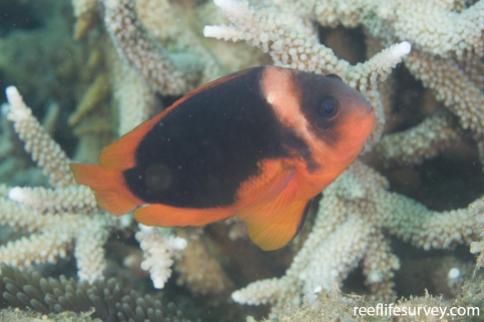Common Name: Redfin Anemonefish
Scientific Name: Amphiprion rubrocinctus Richardson, 1842
Distribution: Western Australia, from Exmouth to Groote Eylandt
Type Locality: Broome, Western Australia
Identification: Single stripe, which often fades in large specimens. Ventral fins red, except for a dark leading edge to the pelvic fins. Both sexes with black well-developed along the back and sides.
Similar: Females of A. frenatus are virtually identical, especially relative to immature specimens of A. rubrocintus that haven’t yet lost their stripe; biogeography is the best means to separate them. Males of A. frenatus are far more red and lack the dark leading edge to the pelvic fins. A. melanopus and A. cf melanopus have dark pelvic fins. Amphiprion barberi has similarly colored ventral fins, but it has a well-developed stripe and little dorsal darkening. Amphiprion ephippium also has red fins, and large specimens with more-muted colors can appear quite similar; it differs in lacking any trace of a stripe, usually lacking the dark leading edge to the pelvic fins, and having an orange, rather than red, color.
Notes: This is a rarely seen species in the aquarium trade, though it was long confused with the superficially similar A. barberi of Fiji before that species’ description. Other common names for this fish include the “Red Anemonefish” and “Australian Anemonefish”, neither of which is terribly informative or very widely used, so I have chosen to amend it to the “Redfin Anemonefish”, highlighting the crimson pelvic fins that serve to separate it from its closest relative, A. melanopus.
It’s surprising that this fish hasn’t been reported from the southernmost reefs at Houtman Abrolhos. The preferred host anemone, Entacmaea quadricolor, and these are home to another West Australian endemic, A. milii. Is this evidence of competitive exclusion, or has this species’ presence simply been missed? Neither explanation feels convincing.















